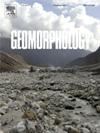An archaoseismological investigation of the footprints of human resilience to seismic shaking from the alluvial plains of Gujarat, Western India
IF 3.1
2区 地球科学
Q2 GEOGRAPHY, PHYSICAL
引用次数: 0
Abstract
The town of Vadnagar, located on a prominent geomorphic surface ∼ Gujarat Alluvial Plains (GAP) of western India, presents unabetted human occupation for the last 2754 years. An integrated archaeoseismological study (involving tectonogeomorphology, geophysical and geoarchaeological investigation) in the Cambay basin led to the identification of a previously un-noticed the reverse splay fault for the first time with the evidence of the surface rupture in the GAP region. The present study based on electrical resistivity tomography (ERT) and previous investigation of magnetotulleric geophysical surveys in the vicinity, demonstrates it to be the ruptured splay of the East Margin Cambay Basin Fault. The timing of the event is constrained ∼1200–2000 years Before Present (BP) using optical dating, whereas archaeological findings briefs it around 9th – 10th Century CE. Additionally, based on the various empirical relationships between magnitude and maximum displacement of 1.6 m observed in the trench, the magnitude of the event was constrained at Mw 7 ± 0.3. In addition to this, our investigation in the vicinity of the site reveals the tectono-geomorphic expressions of the identified Vadnagar Fault and associated archaeological seismic deformations (i.e. collapsed structures, tilted, and rotated wall fragments) along the hanging wall. The presence of timber-bondings in masonry walls (1st – 4th century CE) suggests earthquake resistant structural know-how in Vadnagar as one of the oldest in Asia. We invite more in-depth scrutiny by seismologists and geologists for assessing the realistic hazard of GAP in light of this new seismic source and the human resilience to earthquakes.
求助全文
约1分钟内获得全文
求助全文
来源期刊

Geomorphology
地学-地球科学综合
CiteScore
8.00
自引率
10.30%
发文量
309
审稿时长
3.4 months
期刊介绍:
Our journal''s scope includes geomorphic themes of: tectonics and regional structure; glacial processes and landforms; fluvial sequences, Quaternary environmental change and dating; fluvial processes and landforms; mass movement, slopes and periglacial processes; hillslopes and soil erosion; weathering, karst and soils; aeolian processes and landforms, coastal dunes and arid environments; coastal and marine processes, estuaries and lakes; modelling, theoretical and quantitative geomorphology; DEM, GIS and remote sensing methods and applications; hazards, applied and planetary geomorphology; and volcanics.
 求助内容:
求助内容: 应助结果提醒方式:
应助结果提醒方式:


